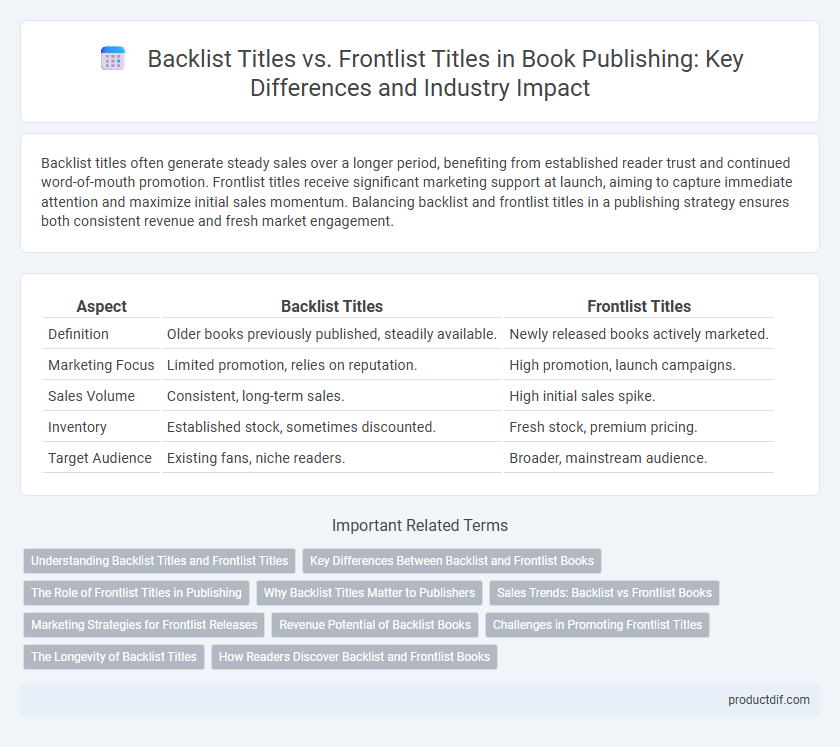Backlist titles often generate steady sales over a longer period, benefiting from established reader trust and continued word-of-mouth promotion. Frontlist titles receive significant marketing support at launch, aiming to capture immediate attention and maximize initial sales momentum. Balancing backlist and frontlist titles in a publishing strategy ensures both consistent revenue and fresh market engagement.
Table of Comparison
| Aspect | Backlist Titles | Frontlist Titles |
|---|---|---|
| Definition | Older books previously published, steadily available. | Newly released books actively marketed. |
| Marketing Focus | Limited promotion, relies on reputation. | High promotion, launch campaigns. |
| Sales Volume | Consistent, long-term sales. | High initial sales spike. |
| Inventory | Established stock, sometimes discounted. | Fresh stock, premium pricing. |
| Target Audience | Existing fans, niche readers. | Broader, mainstream audience. |
Understanding Backlist Titles and Frontlist Titles
Backlist titles are previously published books that remain in print and continue to generate steady sales over time, often representing an author's established works or evergreen subjects. Frontlist titles refer to newly released books that publishers actively promote to maximize initial sales and market attention. Understanding the difference between backlist and frontlist titles helps publishers and booksellers strategically manage marketing efforts and inventory to optimize revenue.
Key Differences Between Backlist and Frontlist Books
Backlist titles consist of previously published books that continue to generate steady sales, while frontlist titles refer to new releases actively promoted by publishers for initial market impact. Key differences include marketing focus, with frontlist books receiving intense advertising and distribution efforts, whereas backlist titles benefit from established reputations and consistent consumer demand. Sales trends also vary as frontlist titles aim for rapid revenue growth, contrasting with the long-term sales longevity typical of backlist catalogues.
The Role of Frontlist Titles in Publishing
Frontlist titles are newly released books that generate significant buzz and drive immediate sales, playing a crucial role in establishing an author's current market presence and publisher revenue. These titles often feature innovative content and targeted marketing campaigns, boosting visibility and consumer interest at launch. Publishers rely on frontlist titles to create momentum, attract media attention, and build the foundation for future backlist sales.
Why Backlist Titles Matter to Publishers
Backlist titles generate steady revenue for publishers by maintaining long-term sales without the high marketing costs associated with frontlist releases. These titles benefit from accumulated reader reviews, word-of-mouth, and established market presence, ensuring ongoing discoverability and profitability. Backlist books also provide a valuable catalog that supports financial stability and enables investment in new frontlist projects.
Sales Trends: Backlist vs Frontlist Books
Backlist titles consistently demonstrate stable and long-term sales, often outperforming frontlist titles which experience a sharp sales peak shortly after release. Consumer behavior indicates a growing preference for backlist books due to established reviews and lower price points, resulting in sustained revenue streams. Publishing data reveals that backlist sales can constitute up to 60% of a publisher's total revenue over time, highlighting the critical financial impact of these titles.
Marketing Strategies for Frontlist Releases
Marketing strategies for frontlist titles prioritize generating immediate buzz through targeted social media campaigns, influencer partnerships, and pre-order incentives. Frontlist releases benefit from coordinated book tours, launch events, and media appearances to maximize visibility and early sales momentum. Leveraging advanced analytics to identify key reader demographics enhances promotional efficiency compared to backlist titles, which rely more on long-term discoverability and catalog sales.
Revenue Potential of Backlist Books
Backlist titles often generate steady and enduring revenue due to their established readership and consistent market demand, unlike frontlist titles that rely heavily on initial sales bursts. Sales data reveals that backlist books can contribute up to 60% of a publisher's total revenue over time, benefiting from ongoing discoveries and word-of-mouth promotion. Strategic marketing efforts targeting backlist titles capitalize on their proven longevity and reduced promotional costs, maximizing profit margins.
Challenges in Promoting Frontlist Titles
Promoting frontlist titles faces challenges such as limited consumer awareness and stiff competition with well-established backlist titles that have proven popularity and sustained sales. Frontlist titles require significant marketing investments to build visibility and credibility in a crowded market where retailers and readers often favor familiar backlist works. Limited timeframes for promotional campaigns further complicate efforts to generate sustained interest and long-term sales momentum for newly released books.
The Longevity of Backlist Titles
Backlist titles maintain steady sales over extended periods, often outlasting frontlist titles that experience brief sales spikes upon release. Backlist books benefit from established word-of-mouth, consistent discoverability, and often lower price points, contributing to ongoing revenue streams for publishers and authors. These enduring works frequently become staples in libraries, educational curricula, and digital platforms, solidifying their long-term market presence.
How Readers Discover Backlist and Frontlist Books
Readers often discover frontlist titles through targeted marketing campaigns, book launches, and new release promotions by publishers and retailers. Backlist titles gain exposure via word-of-mouth recommendations, online reviews, and curated reading lists on platforms like Goodreads and Amazon. Both types benefit from digital algorithms, but backlist books rely more on sustained reader interest and library holdings for ongoing discovery.
Backlist Titles vs Frontlist Titles Infographic

 productdif.com
productdif.com